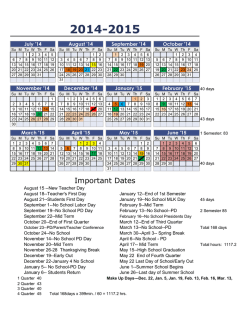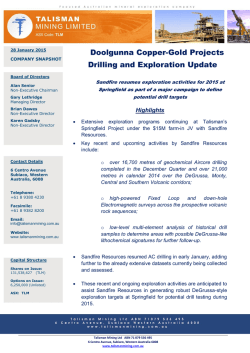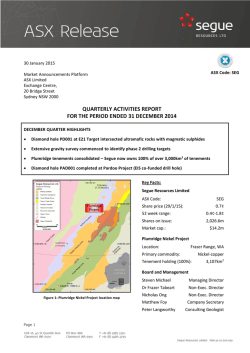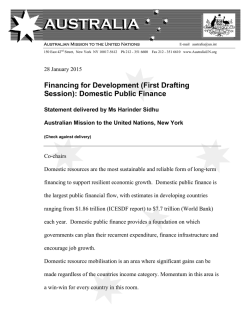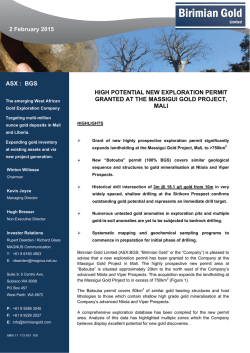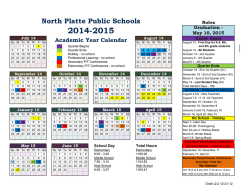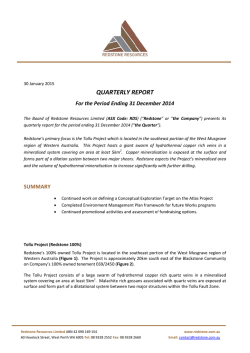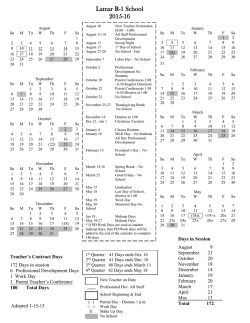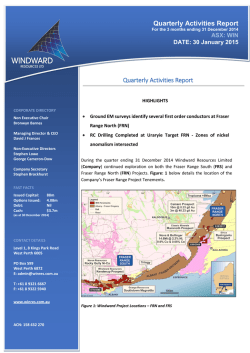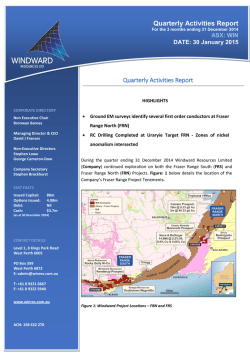
For personal use only - Australian Securities Exchange
December 2014 Quarterly Activities Report Highlights For personal use only Big Red Project, Fraser Range Rumble Resources Ltd Maiden drilling program completed at Big Red with 4 Mud Rotary/Diamond drill holes totalling 1503.9m Suite 9, 36 Ord Street, West Perth, WA 6005 Assays confirm mineralised sulphide zones in Fraser Range Gabbro with the gabbro high in Fe–Ti–V with anomalous Copper, Nickel and Cobalt T +61 8 6555 3980 Each hole intersected multiple horizons of Fraser Range Gabbro containing disseminated magmatic sulphides with trace chalcopyrite (copper sulphide) Downhole EM completed with preliminary work showing multiple off hole conductors discovered, a number being of high conductance Confirmation of a mineralised system within Fraser Range Gabbro makes the significant off hole conductors high grade targets as they may represent massive sulphide accumulations Bedrock conductor modelling continuing with detailed petrology and lithogeochemical analysis progressing for the next phase of drilling F +61 8 6555 3981 rumbleresources.com.au ASX RTR Executives & Management Mr Shane Sikora CEO Mr Terry Topping Executive Director Mr Andrew McBain Non-executive Director Zanthus Project, Fraser Range As part of a planned systematic exploration program Rumble is fast tracking approvals to complete a high impact drilling program in March 2015 Rumble will drill 5 shallow bedrock conductors across the Zanthus eye feature 20km’s east of the Nova-Bollinger nickel copper massive sulphide discoveries 5 RC holes for 750 metres will be completed with 3 highly conductive bedrock conductors priority targets Rumble is fully funded to complete the drill program with the added bonus of a $150k EIS drilling grant from the WA government Corporate Rumble successfully completed a placement to Australian institutional and sophisticated investors to raise a total of $1.15mil Rumble Resources Ltd (“Rumble” or “the Company”) is pleased to provide an update of the Company’s activities. Rumble’s activities were focussed on its Maiden drill program at its Big Red Project and scheduling the next maiden drill program at its Zanthus Project, offering considerable leverage to Rumble shareholders. Mr Matthew Banks Non-executive Director Mr Michael Smith Non-executive Director Mr Bruno Seneque Company Secretary For personal use only Primary Exploration Activities – Fraser Range Figure 1 Big Red and Zanthus Project Locations – Fraser Range Big Red, Fraser Range The Big Red Project is located 450 kilometres east of Kalgoorlie in the Fraser Range Western Australia. A maiden drill program was completed consisting of 4 Mud Rotary/Diamond drill holes totalling 1,503.9m with the programme designed to test a 2km EM conductor outlined by a high powered ground EM survey The first hole reached 240m but was abandoned through difficult drilling conditions. All three subsequent holes reached target depth. Rumble received all assays from its maiden drill program with the assays confirming all three holes intersected large disseminated mineralised sulphide zones within gabbros of the Fraser Range Complex. These sulphide zones are of considerable widths and indicate this large conductor to be a significant mineralised system. Intersecting Fraser Range gabbro is of significance as it is the rock unit which can host magmatic Ni-Cu sulphide deposits. Figure 2. Disseminated sulphides in core Geochemistry For personal use only A review of the geochemistry indicates that all three holes intersected significant zones of Fraser Range gabbro with the largest over 40 metres thick. These gabbro sequences are generally low in MgO (4.0% to 9.0%) high in Iron and Titanium oxides and of significance have zones of disseminated mineralised sulphides. These high Iron (6.0 to 10.8%) and Titanium (0.5 to 2.04% TiO2) oxide minerals are important indicators as to the fractionation history of the magma and more detailed work will help determine the effective mechanism required to concentrate these oxide minerals from the parent magma. The sulphides zones are anomalous in copper (50 to 435ppm), nickel (40 to 230ppm) and cobalt (30 to 54ppm). It is thought that the Big Red gabbro could be part of a layered mafic/ultramafic sequence and further geochemistry is now being undertaken along with detailed petrographic studies of the sulphide zones. The Big Red gabbro also shows evidence of hybridisation. The GSWA has identified two main types of hybrid gabbros in the Fraser Range. These are formed where the main gabbros have incorporated felsic material through assimilation or magma mixing. They are formed through two distinct processes and are located throughout the Fraser Range. The Big Red gabbro forms part of Hybrid Group 1 which is enriched in Thorium and has high Th/La ratios. These gabbro units are thought to have been formed from the incorporation of surrounding felsic material into the main gabbro melt during ascent or emplacement. The Company is now obtaining more detailed Platinum Group Element and Rare Earth Element geochemistry to further investigate the evolution of the Big Red gabbro to aid in future target generation for magmatic Nickel and Copper sulphides. DHEM - Downhole EM Program Rumble completed a DHEM program on the three holes that reached target depth. Ongoing modelling is being completed with the DHEM survey indicating numerous off hole conductors with 2 of high conductance modelled to date which may represent massive sulphide accumulations. BRBDD002 has a broad off hole anomaly centred at 420m downhole and is sourced dominantly above and left of the hole (South west). This area contains both a gabbro unit with mineralised sulphides and a highly magnetic meta-sedimentary unit. BDD003 has strong local off hole anomalies have been modelled 20m off hole centred at 390 to 400m downhole level. This area contains both a gabbro unit with mineralised sulphides and a highly magnetic meta-sedimentary unit. The results indicating multiple bodies of high conductance levels (~6000-8000S). BDD004 has a broad off hole anomaly centred at 300-310m down hole, source below right (Northeast) at 100m. This area is close to a gabbro unit with mineralised sulphides. Figure 3 & 4. Model of 2 conductors of high conductance surrounding hole BDD003. NEXT STAGE EXPLORATION For personal use only Rumble has identified mineralised magmatic sulphide zones within a Fraser Range gabbro. In close proximity are significant bedrock conductors which may represent massive sulphide accumulations which are high priority targets. Before the next stage of drilling is to commence the next phase of technical work will need to be completed which will include: Detailed modelling of the Bedrock Conductors to determine the strike, dip and depth of the bodies. Detailed petrographic analysis of the magmatic sulphides; Lithogeochemical analysis of any rare earth and platinum group elements to determine if any fractionation trends are present; Based on the results of this work the next phase of drilling will be planned in 2015 following the Zanthus drilling program. East MGA_51 North MGA_51 Dip Azimuth Total Depth metres BRDD001 689703 6648599 -60 270 241.3 BRDD002 689710 6648600 -60 270 432.1 BRDD003 689704 6648802 -70 270 422.8 BRDD004 689602 6648295 -70 270 409.1 Table 1 Drill collars – Big Red Project drilling Zanthus Project, Fraser Range The Zanthus Project is located 20km’s east of the Nova-Bollinger nickel copper massive sulphide discoveries in the Fraser Range, Western Australia. Rumble is earning up to 75% from Blackham Resources Ltd (ASX:BLK). As part of a planned systematic exploration program Rumble is fast tracking approvals to complete a high impact drilling program in March 2015. The program will consist of 5 RC holes for 750 metres. Rumble will be targeting 5 bedrock conductors which may represent magmatic massive Nickel Sulphides See Figure 5. They are located in and around an “eye” feature interpreted as an elliptical magnetic rimmed intrusive body some 2km in length and up to 1km wide and of similar size to the Nova “eye” feature. ZC1, ZC2 and ZC3 are of high conductance and will be a priority for the upcoming drill program. See Figure 6. ZC4 and ZC5 – These targets will also be tested as part of the current drill program. Figure 5. Zanthus Eye Conductors For personal use only “Eye” shaped magnetic features are indicators commonly associated with mafic intrusive complexes that host Ni-Cu-PGE ore bodies and are therefore priority targets when looking for ore bodies that can contain zones of massive sulphides. The world class Nova massive Sulphide Nickel Copper Discovery was found through drilling a bedrock conductor within an “eye” intrusive. Figure 6. ZC1, ZC2 & ZC3 of high conductance which are high priority drill targets. EIS Funding - $150k drilling grant Rumble announced on December 16th 2014 its application for the WA State Government’s Exploration Incentive Scheme (EIS) was successful at Zanthus. Rumble was awarded up to $150,000 in co-funding to drill test the highly prospective Zanthus Project bedrock conductors. The $150k grant will enable Rumble to utilise its cash reserves to fund further exploration on other Fraser Range exploration programs. The EIS is a competitive process with the company now receiving grants for both the Big Red and Zanthus projects highlighting the prospectivity of Rumbles Fraser Range projects. Figure 7 Zanthus Project highlighting the eye feature, structural corridor and intrusive targets. Thunderstorm Project, Fraser Range - RTR owns 100% No exploration was completed. Beadell Project, Western Australia No exploration was completed. Canegrass Project Western Australia No exploration was completed. For personal use only Paulsens South Western Australia Subsequent to the end of the Quarter the Company withdrew from the Project and will retail no further interest.. Burkina Faso Permits, West Africa No Exploration Work Completed. Corporate Rumble Resources Ltd successfully completed a placement to Australian institutional and sophisticated investors to raise a total of $1.15mil by the issue of fully paid ordinary shares at $0.045 per share (“Placement”) together with a 1 for 2 attaching listed option exercisable at $0.08 per share. The proceeds from the placement have been used to fund exploration at our Fraser Range Projects in Western Australia. Shane Sikora CEO - ENDS - For further information visit rumbleresources.com.au or contact [email protected]. About Rumble Resources Ltd Rumble Resources Ltd is an Australian based exploration company, officially admitted to the ASX on the 1st July 2011. Rumble was established with the aim of adding significant value to its current gold and base metal assets and will continue to look at mineral acquisition opportunities both in Australia and abroad. Competent Persons Statement The information in this report that relates to Exploration Results is based on information compiled by Mr Terry Topping, who is a Member of the Australasian Institute of Mining & Metallurgy and the Australian Institute of Geoscientists. Mr Topping is a fulltime employee of Rumble Resources Limited and has sufficient experience relevant to the style of mineralisation and type of deposit under consideration and to the activity which he is undertaking to qualify as a Competent Person as defined in the 2012 Edition of the “Australasian Code for Reporting of Exploration Results, Mineral Resources and Ore Reserves”. Mr Topping consents to the inclusion in the report of the matters based on his information in the form and context in which it appears. Appendix In accordance with Listing Rule 5.3.3. Rumble provides the following information in relation to its mining tenements. For personal use only 1. The mining tenements held at the end of each quarter and their location. Project Tenement Number Status Location Beneficial Percentage Interest Paulsens South Paulsens South E08/1457 Granted Western Australia 0% Note 1 Granted Western Australia 0% Note 1 Granted Western Australia 100 Granted Western Australia 80% Granted Western Australia 80% Granted Western Australia 80% Granted Western Australia 90% Application Western Australia 80% Paulsens South Beadell Beadell Beadell Beadell Beadell E08/1765 E08/2257 E45/2405 E45/4267 E45/4223 E45/4186 E45/4494 Canegrass E29/783 Granted Western Australia Big Red E28/2268 Granted Western Australia Big Red E69/3190 Granted Western Australia Big Red E29/2499 Application Western Australia Big Red E29/2500 Application Western Australia Zanthus E69/2506 Granted Western Australia Zanthus E28/2464 Application Western Australia Zanthus E 28/2466 Application Western Australia Thunderstorm E28/2322 Granted Western Australia Thunderstorm E28/2472 Application Western Australia Thunderstorm E 28/2382 Application Western Australia Thunderstorm E28/2471 Application Western Australia Derosa Bompela Derosa Sapala Nanemi Granted Granted Granted Burkina Faso Burkina Faso Burkina Faso 90% 100% 100% 100% 100% 20% Note 3 100% 100% 100% 100% 100% 100% 85% Note 2 85% Note 2 100% Villibongo Granted Burkina Faso 100% Burkina Faso Pogoro Granted Burkina Faso 100% Burkina Faso Yalore Granted Burkina Faso 100% Burkina Faso Burkina Faso 2. Mining tenements acquired during the quarter and their location: None acquired. For personal use only 3. Mining tenements disposed of during the quarter and their location: Project Tenement Number Status Location Comment Paulsens South E47/1765 Granted Western Australia Relinquished Paulsens South E47/2503 Granted Western Australia Relinquished Note: 1. Paulsens South Project, Western Australia E08/1457 and E47/1765 is subject to a Joint Venture agreement with Venture Minerals Ltd whereby Rumble can earn up to a 70% interest in these licences. Subsequent to the end of the Quarter the company withdrew from the Joint Venture and will retain no interest in the Project. 2. Derosa Project, Burkina Faso Bompela and Sapala are subject to a Joint Venture agreement with Canyon Resources limited whereby Rumble owns 85% interest and Canyon a 15% interest. 3. Zanthus Project, Western Australia E69/2506 is subject to a Joint Venture agreement with Blackham Resources Ltd whereby Rumble can earn up to a 75% interest in the licence. Section 1 Sampling Techniques and Data JORC Code explanation Sampling techniques Nature and quality of sampling (eg cut channels, random chips, or specific specialised industry standard measurement tools appropriate to the minerals under investigation, such as down hole gamma sondes, or handheld XRF instruments, etc). These examples should not be taken as limiting the broad meaning of sampling. Include reference to measures taken to ensure sample representivity and the appropriate calibration of any measurement tools or systems used. Aspects of the determination of mineralisation that are Material to the Public Report. In cases where ‘industry standard’ work has been done this would be relatively simple (eg ‘reverse circulation drilling was used to obtain 1 m samples from which 3 kg was pulverised to produce a 30 g charge for fire assay’). In other cases more explanation may be required, such as where there is coarse gold that has inherent sampling problems. Unusual commodities or mineralisation types (eg submarine nodules) may warrant disclosure of detailed information. For personal use only Criteria Drilling techniques Drill type (eg core, reverse circulation, open-hole hammer, rotary air blast, auger, Bangka, sonic, etc) and details (eg core diameter, triple or standard tube, depth of diamond tails, face-sampling bit or other type, whether core is oriented and if so, by what method, etc).. Commentary Moving Loop TEM (MLTEM) Transmitter: Outer Rim HP Current: 90-100A Receiver: SMARTem24 Base Frequency: 0.5Hz Sensor: Fluxgate B-field Components: Bz, Bx, By Mud Rotary (MR) drilling of Pre-collars to depths between 138.8m to 173.5m HQ and NQ2 Diamond drilling to the Bottom of Hole for four holes. Core collected ranges in length from 67.8m to 284.0m. Sampling of the Diamond core has been completed on 1m intervals through the main gabbro units and every 5m through the other intervals. One quarter of the core was then sent for analysis.. Mud Rotary (MR) drilling of Pre-collars to depths between 138.8m to 173.5m HQ and NQ2 Diamond drilling to the Bottom of Hole for four holes. Core collected ranges in length from 67.8m to 284.0m. Diamond drilling and pre-collars undertaken by DDH1 Drilling, utilizing a multipurpose Sandvik 1200 drill rig and associated equipment. Drill sample recovery Method of recording and assessing core and chip sample recoveries and results assessed. Measures taken to maximise sample recovery and ensure representative nature of the samples. Whether a relationship exists between sample recovery and grade and whether sample bias may have occurred due to preferential loss/gain of fine/coarse material. Logging Whether core and chip samples have been geologically and geotechnically logged to a level of detail to support appropriate Mineral Resource estimation, mining studies and metallurgical studies. Whether logging is qualitative or quantitative in nature. Core (or costean, channel, etc) photography. The total length and percentage of the relevant intersections logged. Diamond Core is oriented using an electronic reflex orientation tool at end of each run Diamond drilling recoveries are recorded by the drillers at the end of each drilling run and checked during logging by Rumbles field staff The Diamond core has been geologically logged to a level of detail to be appropriate for mineral resource estimation. Logging of diamond lithology, mineralogy, weathering, colour appropriate features. core records mineralization, and other Criteria JORC Code explanation Commentary All logging is quantitative. All core trays photographed. If core, whether cut or sawn and whether quarter, half or all core taken. If non-core, whether riffled, tube sampled, rotary split, etc and whether sampled wet or dry. For all sample types, the nature, quality and appropriateness of the sample preparation technique. Quality control procedures adopted for all subsampling stages to maximise representivity of samples. Measures taken to ensure that the sampling is representative of the in situ material collected, including for instance results for field duplicate/second-half sampling. Whether sample sizes are appropriate to the grain size of the material being sampled. Quality of assay data and laboratory tests The nature, quality and appropriateness of the assaying and laboratory procedures used and whether the technique is considered partial or total. For geophysical tools, spectrometers, handheld XRF instruments, etc, the parameters used in determining the analysis including instrument make and model, reading times, calibrations factors applied and their derivation, etc. Nature of quality control procedures adopted (eg standards, blanks, duplicates, external laboratory checks) and whether acceptable levels of accuracy (ie lack of bias) and precision have been established. For personal use only Subsampling techniques and sample preparation Verification of sampling and assaying Location of data points Data spacing and distribution All the diamond core (100%), totaling 880.1m has been orientated and geologically logged. The core was cut on 1m intervals through zones of gabbro and 5m intervals through the rest of the hole. A quarter core sample was then sent for analysis. A Cesium vapour magnetometer was used with a 20Hz sampling rate. The base station was a Geometrics G856AX proton precession magnetometer. The radiometric data was obtained using a RSI Spectrometer at a 2 Hz sampling rate. All samples were analysed using a 4 acid ICP method with appropriate quality control measures. The verification of significant intersections by either independent or alternative company personnel. The use of twinned holes. Documentation of primary data, data entry procedures, data verification, data storage (physical and electronic) protocols. Discuss any adjustment to assay data. Accuracy and quality of surveys used to locate drill holes (collar and down-hole surveys), trenches, mine workings and other locations used in Mineral Resource estimation. Specification of the grid system used. Quality and adequacy of topographic control. All data is checked on a daily basis by field staff and consultants Any data points that are questionable are re-surveyed Data spacing for reporting of Exploration Results. Whether the data spacing and distribution is sufficient to establish the degree of geological and grade continuity appropriate for the Mineral Resource and Ore Reserve estimation procedure(s) and classifications applied. Whether sample compositing has been applied. Magnetics data was collected in 0.05 second intervals and Radiometric data at 0.5 second intervals Not applicable as this data is not used in Mineral Resource Estimation. No sample compositing has been applied. Data points were located by a KRA405B altimeter. Elevation values were in AHD. Expected accuracy is 3’ or +/- 3% The grid system is GDA94(MGA), zone 51 Drill hole collars were located by GPS. Expected accuracy is +/- 5m for northing and easting. EM Data - Line Spacing - 300m Station Spacing - 100m Criteria JORC Code explanation Commentary Transmitter Loop Sizes: 200x200m (MLTEM) For personal use only Individual hole collars are spaced 200300m apart. 1m and 5m samples have been collected to reflect the geology and style of mineralisation. There has been no compositing of the data. Orientation of data in relation to geological structure Traverses were undertaken to be perpendicular to the interpreted strike direction and some parallel to the interpreted strike direction. All core was oriented before sampling was completed. Traverses were undertaken to be perpendicular to the interpreted strike direction and some parallel to the interpreted strike direction. All core was oriented before sampling was completed. The measures taken to ensure sample security. Sample security Audits reviews Whether the orientation of sampling achieves unbiased sampling of possible structures and the extent to which this is known, considering the deposit type. If the relationship between the drilling orientation and the orientation of key mineralised structures is considered to have introduced a sampling bias, this should be assessed and reported if material. or The results of any audits or reviews of sampling techniques and data. All magnetics data data has been collected by Thompson Aviation Pty Ltd with data provided to the Companies consultants All EM data has been collected by Outer-Rim Exploration Services with data provided to the companies consultants Chain of custody is managed by Rumble Resources. Drill core is stored on site. Core is palleted and steel strapped, before being transported to Kalgoorlie and then to a laboratory in Perth. No audits or reviews have been carried out at this stage. Section 2 Reporting of Exploration Results JORC Code explanation Commentary Mineral tenement and land tenure status Type, reference name/number, location and ownership including agreements or material issues with third parties such as joint ventures, partnerships, overriding royalties, native title interests, historical sites, wilderness or national park and environmental settings. The security of the tenure held at the time of reporting along with any known impediments to obtaining a licence to operate in the area. The Aeromagnetic survey and EM survey are located wholly within Exploration Licence E69/2506 with Rumble earning up to 75% from Blackham Resources Ltd. Located on Vacant Crown Land. Exploration done by other parties Acknowledgment and appraisal of exploration by other parties. Geology Deposit type, geological setting and style of mineralisation. The only previous exploration includes geophysical surveys by the GSWA and Teck Australia Pty.Ltd. Teck Australia completed two RC/Diamond holes during 2010. Geological setting is the Albany Fraser Mobile Belt consisting of gneiss, mafic rocks including gabbro with significant garnet in the metamorphic rocks. For personal use only Criteria Drill hole Information Data aggregation methods Relationship between mineralisation widths and intercept The drilling is located wholly within Exploration Licence E28/2268, which is 100% owned by Rumble. The tenement is in good standing and no known impediments exist. The Company is exploring for magmatic hosted base metal mineralization A summary of all information material to the understanding of the exploration results including a tabulation of the following information for all Material drill holes: o easting and northing of the drill hole collar o elevation or RL (Reduced Level – elevation above sea level in metres) of the drill hole collar o dip and azimuth of the hole o down hole length and interception depth o hole length. If the exclusion of this information is justified on the basis that the information is not Material and this exclusion does not detract from the understanding of the report, the Competent Person should clearly explain why this is the case. In reporting Exploration Results, weighting averaging techniques, maximum and/or minimum grade truncations (eg cutting of high grades) and cut-off grades are usually Material and should be stated. Where aggregate intercepts incorporate short lengths of high grade results and longer lengths of low grade results, the procedure used for such aggregation should be stated and some typical examples of such aggregations should be shown in detail. The assumptions used for any reporting of metal equivalent values should be clearly stated. These relationships are particularly important in the reporting of Exploration Results. If the geometry of the mineralisation with respect to the drill hole angle is known, its nature should be reported. This information has been previously released to the ASX. There was no weighting or averaging of the data. All widths are at present thought to be true widths. Criteria JORC Code explanation Commentary lengths If it is not known and only the down hole lengths are reported, there should be a clear statement to this effect (eg ‘down hole length, true width not known’). Appropriate maps and sections (with scales) and tabulations of intercepts should be included for any significant discovery being reported These should include, but not be limited to a plan view of drill hole collar locations and appropriate sectional views. The results at this stage are preliminary and work is ongoing. For personal use only Diagrams Balanced reporting Where comprehensive reporting of all Exploration Results is not practicable, representative reporting of both low and high grades and/or widths should be practiced to avoid misleading reporting of Exploration Results. The results presented are preliminary and work is ongoing. Other substantive exploration data Other exploration data, if meaningful and material, should be reported including (but not limited to): geological observations; geophysical survey results; geochemical survey results; bulk samples – size and method of treatment; metallurgical test results; bulk density, groundwater, geotechnical and rock characteristics; potential deleterious or contaminating substances. The nature and scale of planned further work (eg tests for lateral extensions or depth extensions or large-scale step-out drilling). Diagrams clearly highlighting the areas of possible extensions, including the main geological interpretations and future drilling areas, provided this information is not commercially sensitive. Previous ASX releases by Rumble have detailed aspects of previous work undertaken at the project Further work At this stage, the Magnetics and EM data are indicative in nature and require further exploration to establish the true size and nature of the mineralisation, if any. Refer to diagrams in body of report. At this stage, the geology and mineralization intersected is only broadly understood and requires further down hole geophysical surveying and interpretation, as well as further diamond drilling. Appendix 5B Mining exploration entity and oil and gas exploration entity quarterly report Rule 5.5 For personal use only Appendix 5B Mining exploration entity and oil and gas exploration entity quarterly report Introduced 01/07/96 Origin Appendix 8 Amended 01/07/97, 01/07/98, 30/09/01, 01/06/10, 17/12/10, 01/05/2013 Name of entity Rumble Resources Limited ABN Quarter ended (“current quarter”) 74 148 214 260 31 December 2014 Consolidated statement of cash flows Cash flows related to operating activities Current quarter $A’000 1.1 Receipts from product sales and related debtors - Year to date ( 6 months) $A’000 - 1.2 Payments for (a) exploration & evaluation (b) development (c) production (d) administration Dividends received Interest and other items of a similar nature received Interest and other costs of finance paid Income taxes paid Other (provide details if material) (308) (388) 4 (446) (676) 8 3 3 Net Operating Cash Flows (689) (1,112) Cash flows related to investing activities Payment for purchases of: (a) prospects (b) equity investments (c) other fixed assets Proceeds from sale of: (a) prospects (b) equity investments (c) other fixed assets Loans to other entities Loans repaid by other entities Other (provide details if material) (6) - (24) (6) - (6) (30) (695) (1,142) 1.3 1.4 1.5 1.6 1.7 1.8 1.9 1.10 1.11 1.12 1.13 Net investing cash flows Total operating and investing cash flows (carried forward) + See chapter 19 for defined terms. 01/05/2010 Appendix 5B Page 1 Appendix 5B Mining exploration entity and oil and gas exploration entity quarterly report For personal use only 1.13 Total operating and investing cash flows (brought forward) (695) (1,142) Cash flows related to financing activities Proceeds from issues of shares, options, etc. Proceeds from sale of forfeited shares Proceeds from borrowings Repayment of borrowings Dividends paid Other (provide details if material) 1,040 - 1,040 - 1,040 1,040 Net increase (decrease) in cash held 345 (103) 1.20 1.21 Cash at beginning of quarter/year to date Exchange rate adjustments to item 1.20 1.22 Cash at end of quarter 883 1,228 1,330 1,228 1.14 1.15 1.16 1.17 1.18 1.19 Net financing cash flows Payments to directors of the entity, associates of the directors, related entities of the entity and associates of the related entities Current quarter $A'000 1.23 Aggregate amount of payments to the parties included in item 1.2 57 1.24 Aggregate amount of loans to the parties included in item 1.10 - 1.25 Explanation necessary for an understanding of the transactions 1.23 Includes director’s fees and salaries for executive and non-executive directors. Non-cash financing and investing activities 2.1 Details of financing and investing transactions which have had a material effect on consolidated assets and liabilities but did not involve cash flows + See chapter 19 for defined terms. Appendix 5B Page 2 01/05/2013 Appendix 5B Mining exploration entity and oil and gas exploration entity quarterly report For personal use only 2.2 Details of outlays made by other entities to establish or increase their share in projects in which the reporting entity has an interest Financing facilities available Add notes as necessary for an understanding of the position. 3.1 Loan facilities Amount available $A’000 - 3.2 Credit standby arrangements - Amount used $A’000 - Estimated cash outflows for next quarter 4.1 Exploration and evaluation $A’000 350 4.2 Development - 4.3 Production - 4.4 Administration 150 500 Total Reconciliation of cash Reconciliation of cash at the end of the quarter (as shown in the consolidated statement of cash flows) to the related items in the accounts is as follows. Current quarter $A’000 Previous quarter $A’000 5.1 Cash on hand and at bank 1,173 828 5.2 Deposits at call 55 55 5.3 Bank overdraft - - 5.4 Other (provide details) - - 1,228 883 Total: cash at end of quarter (item 1.22) + See chapter 19 for defined terms. 01/05/2010 Appendix 5B Page 3 Appendix 5B Mining exploration entity and oil and gas exploration entity quarterly report For personal use only Changes in interests in mining tenements and petroleum tenements 6.1 6.2 Tenement reference and location Nature of interest (note (2)) Interest at beginning of quarter Interest at end of quarter Interests in mining tenements and petroleum tenements relinquished, reduced or lapsed E47/2503 E45/4233 E08/2256 100% 100% 100% 100% 100% 100% - Interests in mining tenements and petroleum tenements acquired or increased E45/4186 E45/4494 100% 100% - 100% 100% Issued and quoted securities at end of current quarter Description includes rate of interest and any redemption or conversion rights together with prices and dates. 7.1 7.2 7.3 7.4 7.5 Preference +securities (description) Changes during quarter (a) Increases through issues (b) Decreases through returns of capital, buybacks, redemptions +Ordinary securities Changes during quarter (a) Increases through issues (b) Decreases through returns of capital, buybacks +Convertible debt securities (description) Total number Number quoted 150,151,143 150,151,143 26,301,666 26,301,666 Issue price per security (see note 3) (cents) Amount paid up per security (see note 3) (cents) + See chapter 19 for defined terms. Appendix 5B Page 4 01/05/2013 Appendix 5B Mining exploration entity and oil and gas exploration entity quarterly report For personal use only 7.6 7.7 7.8 7.9 7.10 7.11 7.12 Changes during quarter (a) Increases through issues (b) Decreases through securities matured, converted Options (description and conversion factor) Issued during quarter Exercised during quarter Expired during quarter Debentures (totals only) Unsecured notes (totals only) 44,390,569 6,926,996 3,600,000 4,500,000 1,707,316 4,500,000 17,355,000 44,390,569 6,926,996 17,355,000 Exercise price 8 cents 35 cents 35 cents 45 cents 4.1 cents 8 cents 8 cents Expiry date 30 June 2015 31 October 2015 31 October 2015 31 October 2015 13 December 2016 29 July 2018 30 June 2016 17,355,000 17,355,000 8 cents 30 June 2016 - - - - - - - - - - - - Compliance statement 1 This statement has been prepared under accounting policies which comply with accounting standards as defined in the Corporations Act or other standards acceptable to ASX (see note 5). 2 This statement does /does not* (delete one) give a true and fair view of the matters disclosed. Sign here: ............................................................ (Company secretary) Print name: Bruno Seneque Notes + See chapter 19 for defined terms. 01/05/2010 Appendix 5B Page 5 Date: .30 January 2015.. For personal use only Appendix 5B Mining exploration entity and oil and gas exploration entity quarterly report 1 The quarterly report provides a basis for informing the market how the entity’s activities have been financed for the past quarter and the effect on its cash position. An entity wanting to disclose additional information is encouraged to do so, in a note or notes attached to this report. 2 The “Nature of interest” (items 6.1 and 6.2) includes options in respect of interests in mining tenements and petroleum tenements acquired, exercised or lapsed during the reporting period. If the entity is involved in a joint venture agreement and there are conditions precedent which will change its percentage interest in a mining tenement or petroleum tenement, it should disclose the change of percentage interest and conditions precedent in the list required for items 6.1 and 6.2. 3 Issued and quoted securities The issue price and amount paid up is not required in items 7.1 and 7.3 for fully paid securities. 4 The definitions in, and provisions of, AASB 6: Exploration for and Evaluation of Mineral Resources and AASB 107: Statement of Cash Flows apply to this report. 5 Accounting Standards ASX will accept, for example, the use of International Financial Reporting Standards for foreign entities. If the standards used do not address a topic, the Australian standard on that topic (if any) must be complied with. == == == == == + See chapter 19 for defined terms. Appendix 5B Page 6 01/05/2013
© Copyright 2026
